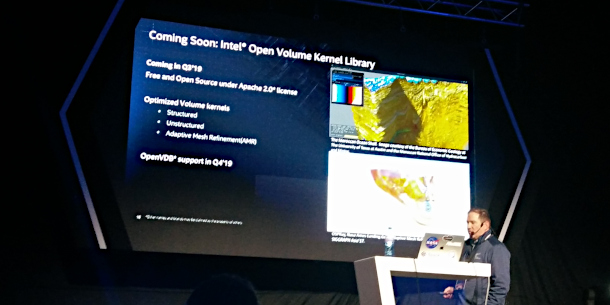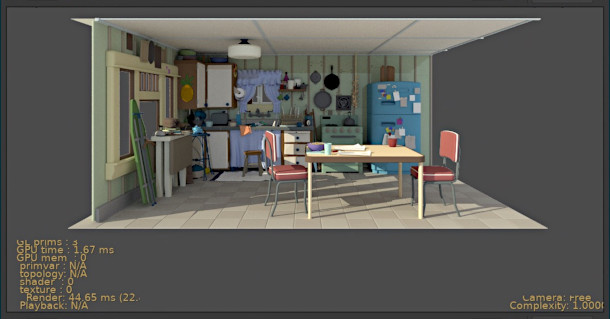Intel unveils HdOSPRay and OpenVKL

Intel’s Jim Jeffers discusses OpenVKL, the firm’s upcoming open-source library of algorithms for CPU-based volumetric rendering, at Chaos Group’s Total Chaos conference last month.
Originally posted on 4 June 2019. Scroll down for news of the release of OpenVKL.
Intel has announced OpenVKL (Open Volume Kernel Library), a new open-source library of CPU-based algorithms for rendering 3D volumetric effects.
The library, which is due to become publicly available later this year, will become the latest addition to Intel’s open Rendering Framework, alongside other recent additions like Open Image Denoise.
Intel has also released HdOSPRay, an open-source plugin for Pixar’s Universal Scene Description software, extending USD’s existing Hydra rendering framework with Intel’s OSPRay ray tracer.
OpenVKL: a ‘highly optimised’ set of algorithms for rendering volumetrics on the CPU
Intel actually talked about OpenVKL at FMX earlier this year, but we first came across it during a presentation by Intel senior principal engineer Jim Jeffers at Total Chaos 2019.
Jeffers described it as a counterpart to Embree – Intel’s set of open-source ray tracing kernels, now integrated into a range of real-time and offline render engines – for volumetric rendering.
The framework is due to ship in Q3 2019, with support for the popular open-source OpenVDB volumetric format to follow in Q4 2019.
Updated 24 August 2020: OpenVKL has been released, and has now gone through several alpha builds.
The product website has also been updated with demo images of volumetrics rendered using OpenVKL: the video above was rendered in OSPRay, but there are several still images rendered in Houdini.

Pixar’s standard kitchen scene rendered with full path tracing in USD’s default usdview viewer via HdOSPRay, Intel’s open-source plugin for the Universal Scene Description software.
HdOSPRay: hardware-accelerated ray tracing in USD’s Hydra rendering framework
Intel is also supporting another key open standard in VFX production, Pixar’s Universal Scene Description format, via its HdOSPRay plugin.
The new interactive rendering plugin, which has been available in beta since February, extends USD’s Hydra rendering framework with OSPRay, Intel’s open-source ray tracing engine.
Jeffers described the move as the first “direct pitch” at the visual effects industry for OSPRay, which has been more widely integrated into scientific visualisation tools.
Despite being initially “written off” by DCC tools developers in comparison to Embree, Jeffers described OSPRay as capable of handling very heavy VFX and animation production data sets.
In Intel’s own tests on Pixar’s standard kitchen scene, the OSPRay-powered Hydra viewer displayed the asset at 62fps with ‘basic’ ray tracing, as opposed to 191fps for OpenGL rasterisation.
While that seems like a reasonable trade-off between performance and visual quality, more advanced display options do reduce performance further.
Full path tracing came in at 31fps on the same test machine, but the figure dropped below 10fps when rendering at 16 samples per pixel.
Availability and system requirements
Source code for OpenVKL is available on GitHub under an Apache 2.0 licence. It can be compiled for Windows, Linux and macOS: you can find instructions for doing so here.
HdOSPRay is also available under an Apache 2.0 licence, with USD 19.03, OSPRay 1.8.5 and Embree 3.2.x as prequisites. At the minute, only the source code is available: there are no compiled binaries.
Intel’s primary development target for HdOSPRay is Linux, so Windows and macOS support is “experimental”.
